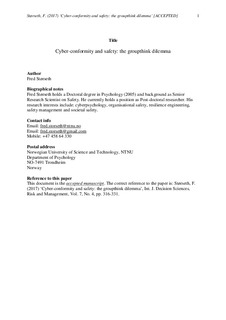| dc.contributor.author | Størseth, Fred | |
| dc.date.accessioned | 2018-12-17T14:09:34Z | |
| dc.date.available | 2018-12-17T14:09:34Z | |
| dc.date.created | 2018-08-07T13:39:01Z | |
| dc.date.issued | 2017 | |
| dc.identifier.citation | International Journal of Decision Sciences, Risk and Management. 2018, 7 (4), 316-331. | nb_NO |
| dc.identifier.issn | 1753-7169 | |
| dc.identifier.uri | http://hdl.handle.net/11250/2577968 | |
| dc.description.abstract | The 'capable group' is part of the ethos in resilience-based safety management. Group ideas draw upon psychology. But, what if the psychological blueprints no longer apply? My thesis is that we are changed by cyber-conformity: A trait-like propensity grooved into our psychology as we immerse ourselves in the ever-present digital social spheres for attention, confirmation and approval of 'the others'. What if cyber-conformity renders aspects of group psychology obsolete? In applied safety, decision-making accentuates group dynamics under pressure. Is the group still 'capable'? The aim is to explore how cyber-conformity spills into group dynamics, and in turn plays out in decision-making. With groupthink as analytical approach, the paper identifies the 'groupthink dilemma', i.e. although the conventional 'ingroup' loses meaning, the dangers of groupthink is as strong as ever. It is discussed how group-based decisions tinted by cyber-conformity forms the potential of 'long distance groupthink' and funnel-vision decision-making. | nb_NO |
| dc.language.iso | eng | nb_NO |
| dc.publisher | Inderscience | nb_NO |
| dc.title | Cyber-conformity and safety: the groupthink dilemma | nb_NO |
| dc.title.alternative | Cyber-conformity and safety: the groupthink dilemma | nb_NO |
| dc.type | Journal article | nb_NO |
| dc.type | Peer reviewed | nb_NO |
| dc.description.version | acceptedVersion | nb_NO |
| dc.source.pagenumber | 316-331 | nb_NO |
| dc.source.volume | 7 | nb_NO |
| dc.source.journal | International Journal of Decision Sciences, Risk and Management | nb_NO |
| dc.source.issue | 4 | nb_NO |
| dc.identifier.doi | 10.1504/IJDSRM.2017.093832 | |
| dc.identifier.cristin | 1600201 | |
| dc.description.localcode | © 2017. This is the authors' accepted and refereed manuscript to the article. The final authenticated version is available online at: https://doi.org/10.1504/IJDSRM.2017.093832 | nb_NO |
| cristin.unitcode | 194,67,40,0 | |
| cristin.unitname | Institutt for psykologi | |
| cristin.ispublished | true | |
| cristin.fulltext | postprint | |
| cristin.qualitycode | 1 | |
